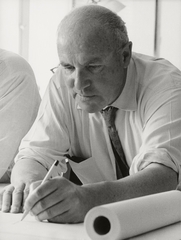Egon Eiermann

As a university lecturer and master builder, Egon Eiermann became one of the most important architects of the post-war period in Germany. His extensive oeuvre includes the residential buildings from the 1930s, the handkerchief weaving mill in Blumberg in 1951, St. Matthew's Church in Pforzheim in 1953, the German Pavilion at the World Exhibition in Brussels in 1958, the new Kaiser Wilhelm Memorial Church in Berlin, and the new building of the German Museum.The German Embassy in Washington in 1964, the Abgeordneten Hochhaus in Bonn in 1969 and the administration buildings for IBM and Olivetti in Stuttgart and Frankfurt in 1970 are among his most important buildings.
Dr. Ing. Jan Krieger
Egon Eiermann Society
Photo: saai, Wolfgang Roth
Biography
1904 Born on 29.09. in Neuendorf, district of Teltow near Berlin.
1922 Abitur at the Althoff-Gymnasium in Nowawes.
1923-1927 Studies architecture at the Technical University in Berlin. Diploma.
1925-1928 Master student with Hans Poelzig.
1925 Film construction at UFA in Babelsberg.
1928-1929 Architect in the construction office at Karstadt AG in Hamburg.
1929-1930 Architect at BEWAG Berlin.
1931-1945 Independent architect in Berlin.
1931-1936 Office partnership with Fritz Jaenecke.
1931 Member of the BDA and the Werkbund.
1941 Stage designs for the Staatliches Schauspielhaus at the Gendarmenmarkt in Berlin.
1945 Destruction of the office moved to Beelitz, flight to Buchen, his father's birthplace.
1946 Self-employed architect in Mosbach in the Odenwald, from 1948 in Karlsruhe.
1946-1965 Office partnership with Robert Hilgers.
1947 Appointed to a chair of architecture at the TH Karlsruhe.
1951 Founding member of the German Design Council.
1955 Member of the Academy of Arts in Berlin.
1962 Berlin Art Prize for Architecture.
1962 Member of the Planning Council for the new buildings of the Bundestag and Bundesrat, Bonn.
1963 Honorary Corresponding Member of the Royal Institute of British Architects, London.
1965 Honorary Doctor of the Technical University of Berlin.
1968 Grand Prize of the BDA. Grand Federal Cross of Merit.
1970 Member of the Order Pour le Mérite for Science and Arts of the Federal Republic of Germany.
1970 Egon Eiermann died on 19 July in Baden-Baden.
